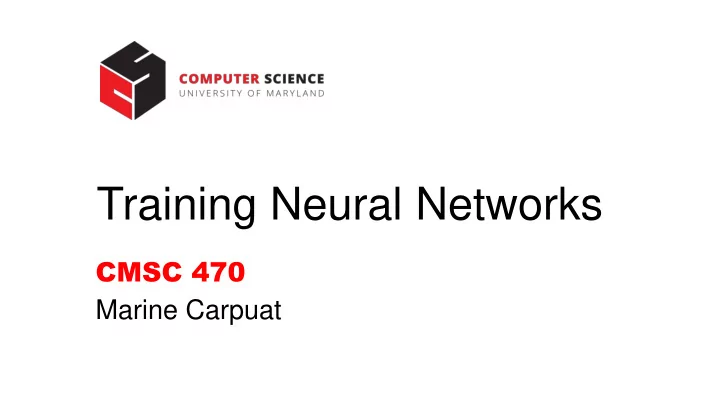

Training Neural Networks CMSC 470 Marine Carpuat
Neural Networks so far • Powerful non-linear models for classification • Predictions are made as a sequence of simple operations • matrix-vector operations • non-linear activation functions • Choices in network structure • Width and depth • Choice of activation function • Feedforward networks • no loop • Next: how to train
Neural Networks as Computation Graphs
Computation Graphs Make Prediction Easy: Forward Propagation consists in traversing graph in topological order
Computation Graph • Graph contains 3 different types of nodes • Parameters of the models (e.g., W1, b1, W2, b2) • Input x • operations between parameters and input (e.g., product, sum, sigmoid) • Acyclical directed graph • No recursion or loops • So far each computation node in the graph should consist of • A function that executes its computation operation • Links to input nodes • When processing an example, the computed value (we’ll add 2 more items to enable training)
How do we train a neural network? For training, we need • Data: (a large number of) examples paired with their correct class (x,y) • Loss/error function: quantify how bad our prediction y is compared to the truth t • E.g. squared error (aka L2 loss) • An algorithm to minimize the loss: stochastic gradient descent
Extending the Computation Graph to Compute the Loss
Computing Gradients: Chain rule decomposes computation of gradient along the nodes
Training Illustrated
Computation Graph • Graph contains 3 different types of nodes • Parameters of the models (e.g., W1, b1, W2, b2) • Input x • operations between parameters and input (e.g., product, sum, sigmoid) • Acyclical directed graph • No recursion or loops • So far each computation node in the graph should consist of • A function that executes its computation operation • Links to input nodes • When processing an example in the forward pass, the computed value • A function that executes its gradient computation • Links to children nodes (to obtain downstream gradient values) • When processing an example in the backward pass, the computed gradient
Computation Graph: A Powerful Abstraction • To build a system, we only need to: • Define network structure • Define loss • Provide data • (and set a few more hyperparameters to control training) • Given network structure • Prediction is done by forward pass through graph (forward propagation) • Training is done by backward pass through graph (back propagation) • Based on simple matrix vector operations • Forms the basis of neural network libraries • Tensorflow, Pytorch, mxnet, etc.
Exploiting parallel processing • Using vector matrix operations helps • E.g., if a layer has 200 nodes a matrix operation Wh requires 200 x 200 = 40000 multiplications • Can benefit from efficient implementations for Graphics Processing Units (GPU) • “ Minibatch ” training by processing multiple examples at a time helps further • Compute parameter updates based on a “ minibatch ” of examples • instead of one example at a time • More efficient: matrix-matrix operations replace multiple matrix-vector operations • Can lead to better model parameters
Neural Networks • Originally inspired by human neurons, but now simply an abstract computational device • Can be thought of as combinations of neural units, where each unit multiplies input by a weight vector, adds a bias, and then applies a non- linear activation function • Or alternatively as a computation graph • Power comes from ability of early layers to learn representations (i.e. features) that can be used by later layers in the network
Neural Networks • Choices in network structure • Width and depth • Choice of activation function • Feedforward networks (no loop) • Forward Propagation: predictions are made as a sequence of simple operations • matrix-vector operations • non-linear activation functions • Training with the back-propagation algorithm • Requires defining a loss/error function • Gradient descent + chain rule • Easy to implement on top of computation graphs
Recommend
More recommend